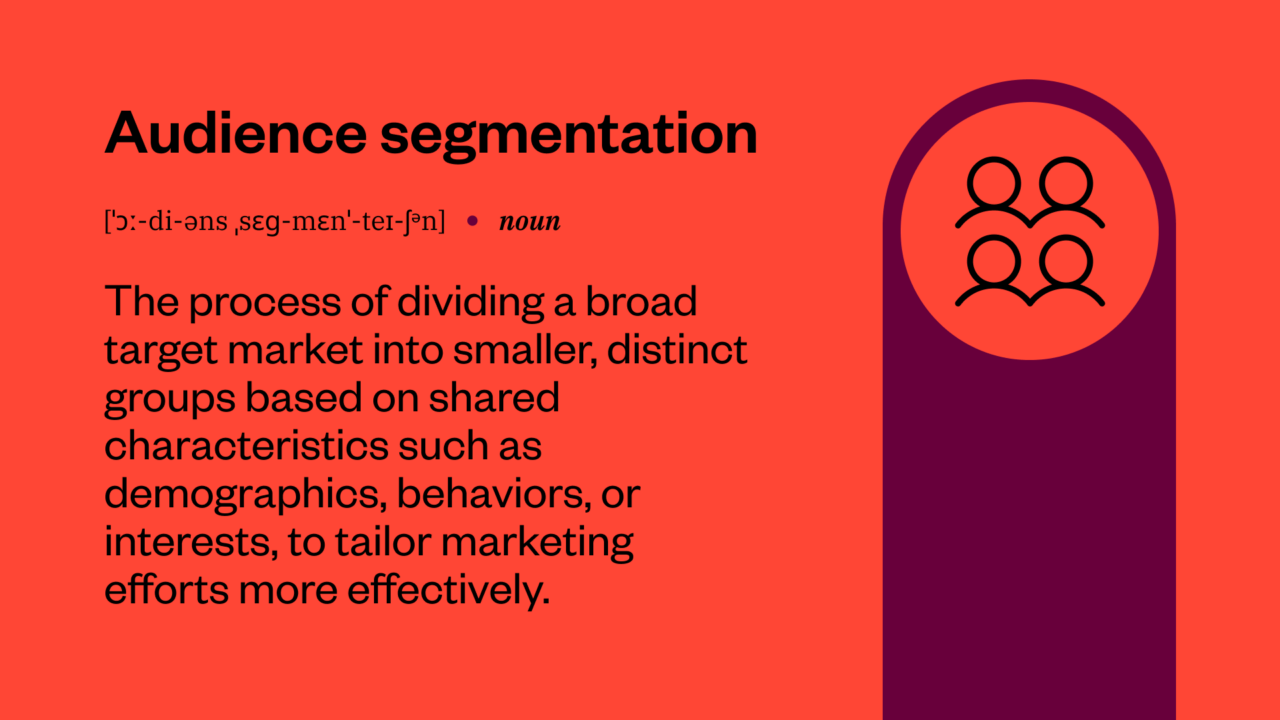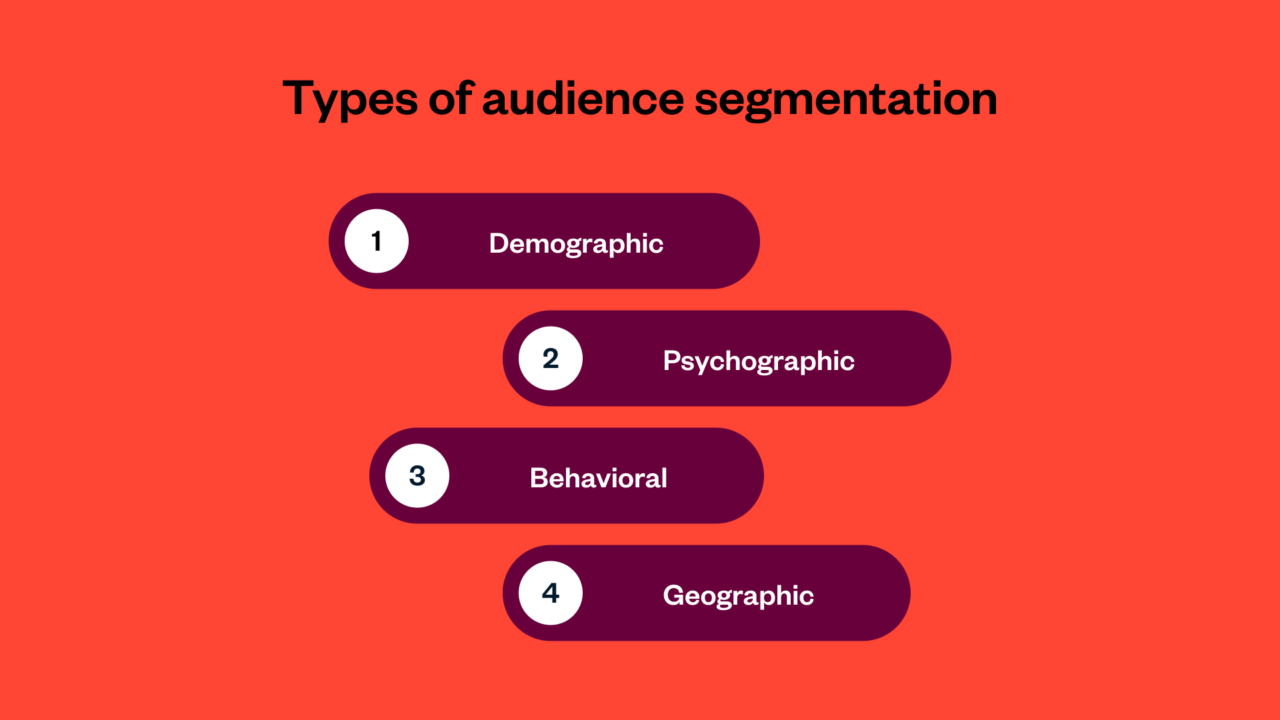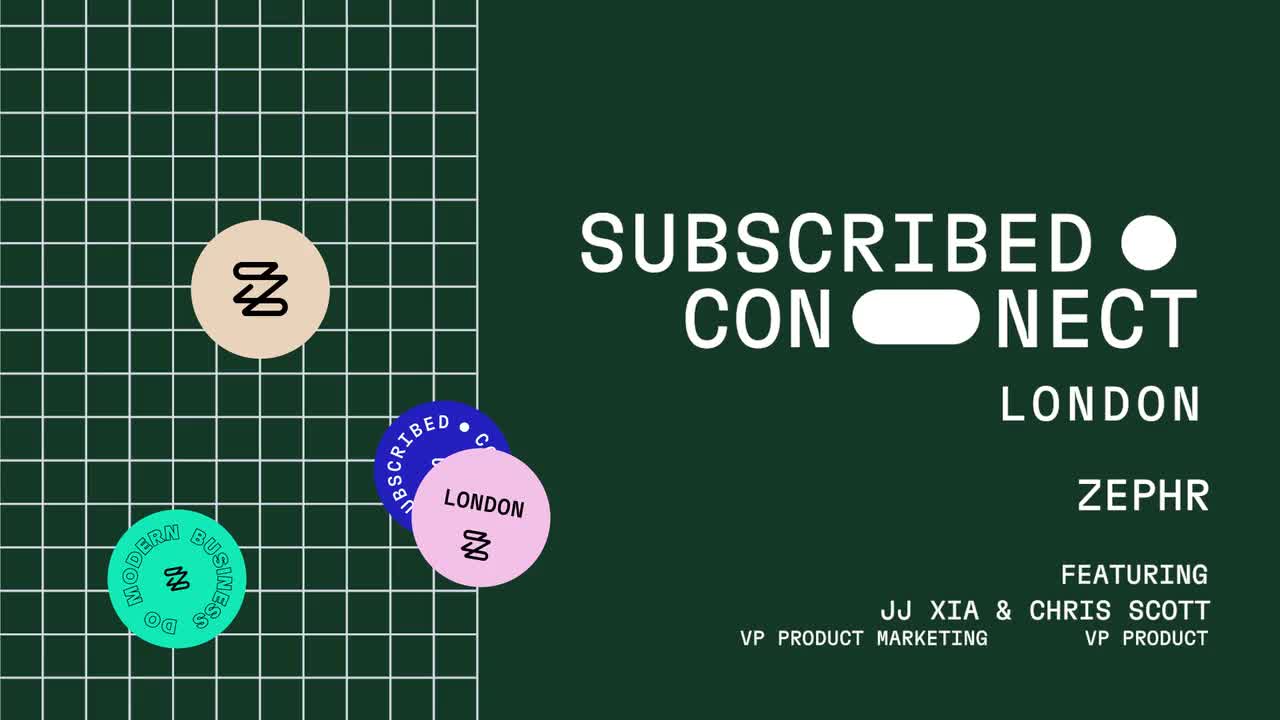Glossary Hub / Audience Segmentation: Keys to Subscription Business Success
Audience Segmentation: Keys to Subscription Business Success

As customer expectations shift at a rapid pace, businesses must adapt to remain at the forefront. The era of generic, one-size-fits-all solutions is behind us, replaced by an undeniable demand for strategies that are personal, data-driven, and resonant.
While expanding pricing options serves as the first step, true business resilience is achieved by concentrating on customer engagement that respects the unique journey of each individual.
This shift underscores the critical need for a profound understanding of subscribers – their preferences, behaviors, and evolving demands. Armed with this knowledge, subscription businesses can effectively segment their audiences and begin crafting unique experiences.
What is Audience Segmentation?

Audience segmentation is the process of dividing a broad customer base into smaller, more manageable groups, based on shared characteristics, behaviors, or needs. This strategy allows businesses to tailor their marketing efforts to meet the specific preferences of each segment, ultimately improving engagement, retention, and conversion rates.
In a subscription business model, audience segmentation goes beyond basic demographics—such as age or location—and delves deeper into customer behavior, preferences, and interactions with the service. Effective segmentation helps businesses answer key questions like:
Who are my most engaged subscribers?
Which customers are at risk of churning?
What types of offers and content will appeal most to specific groups?
The benefits of audience segmentation for subscription businesses
Put simply, blanket messaging and offers can be detrimental to a business’s relationship with its subscribers. Consider the highly competitive streaming industry, where numerous providers with the same content vie for a limited subscriber base. Modern businesses must continually offer what customers value and resonate with most at the right time if they are to succeed.
Through segmentation, businesses gain the ability to create finely-tailored packages, offers, and messaging for different groups using subscription data, payment details, billing records, consumption patterns, and engagement metrics.
This segmentation goes beyond simple list generation; it furnishes businesses with the insights necessary to generate a significant positive effect on their financial performance.
For instance, a company could construct an ultra specific segment of users consisting of “enthusiast” customers with a regular subscription, significant engagement, and a subscription duration of at least three months. These individuals constitute a deeply engaged group, making them prime candidates for potential upsell opportunities.
By crafting this specific segment and keeping it up to date, companies can create exceptionally targeted upsell campaigns that are much more relevant and effective than trying to upsell a whole subscriber base.
This is just one of the myriad ways audience segmentation enhances both customer acquisition and retention. Let’s dive into three more ways in which accurate audience segments enhance subscriber relationships:
1. Proactive churn management
Accurate segments help identify subscribers who may be at risk of churning. By monitoring the behavior and engagement levels of different segments, subscription businesses can detect signs of disengagement early on e.g. cancellation page visits and low usage.
This enables proactive intervention with retention strategies, such as targeted re-engagement campaigns or personalized incentives to keep churn-risk customers on board.
2. Data backed experimentation
The ability to experiment with offers dynamically is a game-changer for subscription businesses. It empowers them to refine their offers for different audience segments to increase customer retention and boost conversion over time.
Businesses can experiment with discount opportunities, test different pricing strategies for different demographics, and even create customized trial periods to reduce involuntary churn.
Tests can also be run on small scale audience segments to prove their effectiveness before rolling out to a larger audience.
This data-backed experimentation ultimately allows businesses to refine their offers continuously, ensuring they meet their customers’ ever-changing needs.
3. Lifelong customer value
By retaining subscribers through the use of accurate audience segments, subscription businesses not only maintain their existing revenue, but also potentially increase customer lifetime value in the process.
Loyal, long-term subscribers are more likely to explore additional products or services and become brand advocates, thereby contributing to a subscription business’s overall growth.
The ability to understand and cater to the unique needs of each subscriber group empowers businesses to enhance customer retention and build strong, enduring relationships.
Types of Audience Segmentation
Effective audience segmentation goes beyond just collecting data; it requires a strategic approach to categorizing that data into meaningful groups. Here are examples of the most common types of segmentation used by subscription businesses:

Demographic Segmentation
This is one of the most basic forms of segmentation and involves dividing your audience based on demographic factors such as:
Age
Gender
Income Level
Occupation
Marital Status
Education Level
Demographic segmentation is useful for understanding broad customer trends and tailoring general messaging. For example, a streaming service might offer family plans to households or exclusive content to users based on age groups (e.g., children’s shows for younger users, classic movies for older ones).
Psychographic Segmentation
Psychographic segmentation takes a deeper dive into your customers’ lifestyles, values, attitudes, interests, and personalities. This type of segmentation helps businesses understand why customers behave the way they do, which is key for creating truly personalized experiences. Psychographic data could include:
Lifestyle (e.g., eco-conscious, tech-savvy)
Interests (e.g., fitness, gaming, travel)
Values and Beliefs (e.g., sustainability, social justice)
Personality Traits (e.g., introverted vs. extroverted)
Psychographic segmentation is ideal for crafting messaging that speaks to a customer’s deeper motivations. For example, a wellness subscription service might target health-conscious individuals with personalized content about nutrition, fitness, and mental well-being.
Behavioral Segmentation
Behavioral segmentation looks at how customers interact with your product or service. This includes:
Purchase History: Frequency and volume of purchases or subscriptions.
Usage Patterns: How often and how extensively they use the service (e.g., daily users vs. occasional users).
Engagement Level: Interaction with emails, push notifications, or in-app messages.
Customer Journey Stage: Whether they are a new customer, long-term subscriber, or at-risk of churning.
Behavioral segmentation is incredibly valuable for crafting highly personalized marketing messages that align with the customer’s interaction history and current needs. For instance, a SaaS company might offer premium features to long-term users who have consistently used the platform but are not yet on the highest tier of service.
Geographic Segmentation
Geographic segmentation divides customers based on their physical location, such as:
Country
Region/State
City
Climate
This type of segmentation is particularly valuable for businesses that offer region-specific services or content. For example, a news subscription service might tailor its content to different regions, offering local news and updates, or a travel-based service might promote destination-specific content based on a user’s location.
Advanced Audience Segmentation Techniques
To truly harness the power of audience segmentation, subscription businesses can go beyond basic demographic or geographic segments and leverage more advanced techniques that take full advantage of modern data collection and analysis tools.
Predictive Segmentation
Predictive segmentation uses machine learning algorithms to forecast future behaviors based on historical data. By analyzing past subscriber interactions, these tools can predict things like churn risk, the likelihood of a customer upgrading their subscription, or which customers are most likely to purchase an additional product. This allows businesses to proactively target specific segments with tailored marketing campaigns designed to maximize retention and increase revenue.
Dynamic Segmentation
Unlike static segmentation, dynamic segmentation allows customer groups to change over time as their behavior and needs evolve. For example, a customer might move from an “introductory offer” segment to an “engaged” segment once they begin using the service more regularly. With dynamic segmentation, businesses can adapt their marketing and engagement strategies in real time, ensuring that each subscriber receives relevant messaging at every stage of their journey.
Micro-Segmentation
Micro-segmentation involves dividing an audience into very small, highly specific segments. These segments might only consist of a few individuals but can be highly valuable for businesses aiming to deliver hyper-targeted content, offers, or experiences. For example, a streaming service could create a micro-segment based on users who have watched a specific series multiple times and then offer them exclusive content or merchandise related to that show. While this approach is more granular, it can lead to significant increases in customer satisfaction and conversion.
How to implement audience segmentation in your subscription business
Implementing effective audience segmentation requires a strategic approach, underpinned by accurate data and the right tools. Here’s how to get started:
1. Collect Relevant Data
The first step in segmentation is gathering data on your subscribers. Key data points for subscription businesses include:
Demographic Data: Information such as age, gender, income level, location, etc.
Behavioral Data: Insights into how users engage with your service (e.g., login frequency, content consumption patterns, time spent on the platform).
Transactional Data: Billing history, payment frequency, upgrades, downgrades, etc.
Engagement Metrics: How often customers interact with your communications, such as email opens, click-through rates, and social media engagement.
2. Use Segmentation Tools
There are various tools and platforms that can help automate and optimize your segmentation efforts. Consider using:
Customer Relationship Management (CRM) Systems: CRMs like Salesforce or HubSpot can help segment customers based on demographic and behavioral data.
Analytics Platforms: Tools like Google Analytics, Mixpanel, or Kissmetrics allow you to track customer behavior and segment users based on their interactions with your platform.
AI-Powered Platforms: Advanced platforms that leverage machine learning and AI, such as Zuora’s Subscriber IQ, can predict customer behaviors and help build dynamic, predictive segments.
3. Create Segments Based on Specific Criteria
Once you’ve collected the necessary data, you can begin creating your segments. The key is to ensure that each segment reflects a group with common interests, behaviors, or needs. For instance:
New Subscribers: Those who have recently signed up but haven’t yet engaged deeply.
Engaged Subscribers: Active users who regularly interact with your content and services.
Churn Risk Subscribers: Customers showing signs of disengagement (e.g., fewer logins, lower activity).
High-Value Subscribers: Long-term customers with a history of spending and engagement.
4. Continuously Refine Segments
Segmentation isn’t a one-time process. As customer behaviors evolve, it’s important to continuously analyze your segments and refine them based on new data. Implement A/B testing to test the effectiveness of different offers or messaging for each segment, and adjust based on the results.
Audience Segmentation and Customer Lifecycle
Audience segmentation plays a crucial role throughout the entire customer lifecycle, helping businesses to optimize their interactions at every stage—from acquisition through to retention and beyond. Here’s how segmentation supports each phase of the customer journey:
Acquisition Stage
In the acquisition phase, segmentation helps businesses target the right audience with the right messaging. For example, a business might target new potential subscribers through ads tailored to their demographic (e.g., age, location) or interests (e.g., specific hobbies or pastimes). Personalized messaging that speaks directly to their needs or pain points can significantly improve conversion rates.
Onboarding Stage
Once a new subscriber has signed up, segmentation ensures that the onboarding process feels personal and relevant. For example, you can create segments based on the subscriber’s preferences or actions during the signup process (e.g., content type preferences, subscription plan choice). By tailoring the onboarding experience to each segment’s interests, you’re more likely to create a positive first impression and encourage long-term engagement.
Engagement Stage
In the engagement phase, segmentation allows businesses to provide ongoing value to their subscribers by delivering personalized content, offers, and recommendations. For example, a fitness app might create segments for beginners, intermediate users, and fitness enthusiasts, offering each group different levels of content and support based on their individual goals and fitness levels. This type of personalization keeps customers engaged and satisfied with the service.
Renewal and Retention Stage
Segmentation is essential in managing renewals and preventing churn. By identifying segments at risk of leaving (e.g., customers who have reduced their usage or have shown dissatisfaction), businesses can target these customers with retention offers, discounts, or special incentives. For example, a subscription service could offer a discount on renewal to high-value customers who have not engaged in the last 30 days.
Taking segmentation to the next level
Truly effective data collection and audience segmentation extends beyond the basics of user demographics. They involve constructing a holistic understanding of subscribers, spanning their entire journey, including transaction history, product usage, demographics, and more.
Subscription businesses with robust data insight and segmentation will delve into payment histories, consumption patterns, decisions to upgrade or downgrade, and even subtle indicators like visits to a cancellation page or credit card renewal dates.
With this data comes an unparalleled understanding of each subscriber. It serves as the foundation for crafting highly personalized offers, a crucial element in achieving success in a subscription business.
In the past, gaining high-quality insights like these proved to be a formidable challenge. Subscribers have often remained enigmatic, akin to a ‘black box,’ with hard to read motivations, consumption habits, and reasons for attrition.
Even for those subscription businesses who are able to collect this data, extracting actionable insights from it can also be a monumental task.
The true challenge lies in translating that data into tangible actions. Businesses must craft offers that boost customer growth and retention at every stage of the journey, and achieving this has often necessitated time-consuming and resource-intensive technical transformations in the past.
However, with new technological advancements, particularly in the field of first party data collection and AI driven data analysis, a higher level of personalization is now within reach. Exciting new advancements in data collection and analysis stand as a beacon of data-driven insight, facilitating more accurate user understanding, and enabling more precise segmentation to help businesses tailor their offerings more effectively.
To see how we’re planning to unlock advanced personalization for every Zuora client, take a look at our demo on Subscriber IQ here:
The power of data-driven, personalized engagement cannot be understated in today’s business landscape. It’s not just about offering more choices to customers; it’s about understanding their evolving needs and preferences, leading to a richer, more dynamic customer experience.
There’s no doubt that the future of subscriber engagement is data-driven, and advanced segmentation gives businesses the tools they need to thrive in an increasingly competitive landscape.